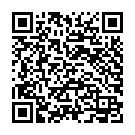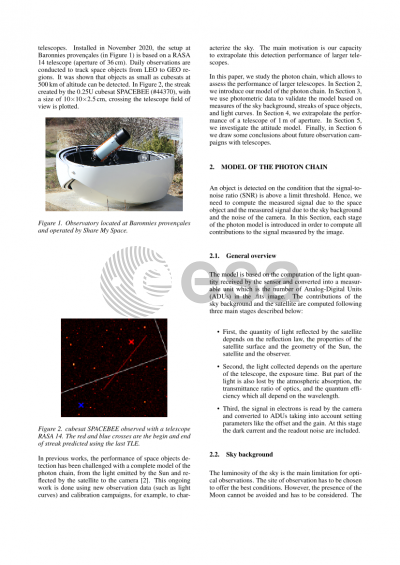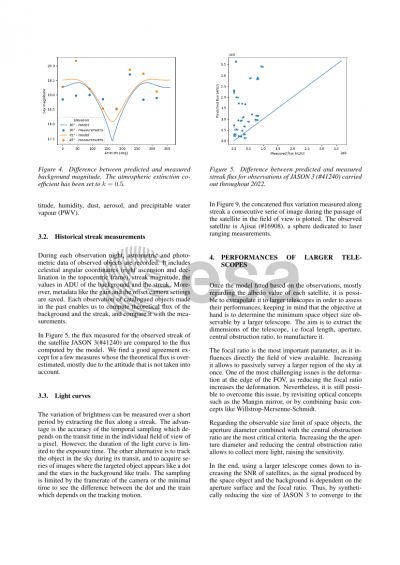Document details

Abstract
With the emergence of the new space industry came a sky-rocketing rise of the Earth-orbiting object population, creating unprecedented challenges for space operations. More than 1 million debris greater than 1 cm pose a threat to current and future space-based activities. They have to be tracked and characterized in order to minimize collision risks and help find solutions towards a sustained outer space.
On top of providing astrometric data, optical observations of Resident Space Objects (RSO) uniquely offer the ability to retrieve the photometric behavior of such objects. Images produced by Share My Space’s ground-based telescope network allow the extraction of the luminous flux of an object over a certain time span: assuming the choice of an appropriate sampling rate, we call such measurements light curves. This information finds applications on several subjects: notably for RSO attitude determination, as well as the validation of the photometric chain model relative to Share My Space’s observatories.
We present two methods for light curves extraction through both passive and active observations. In sidereal tracking, the passive method consists in waiting for the object to travel through the field of view of the instrument to capture its passage. The RSO forms a light streak moving through a series of consecutive images, from which we measure the flux along the trajectory. With active object tracking, images are acquired at higher framerates, forming a point-like object on captures of RSO, showing streak-like stars in the background.
We compare these two ways of extracting light curves, expecting an agreement between variables (flux, characteristic periods) measured using both methods. This also helps raising particular observing scenarios that would favor one of the two methods: with small or distant objects for example. These results are confronted to predictions made by our photometric model, allowing the verification of the simulation algorithms used, as well as their refinement through the addition of new attitude parameters. Performing light curve analysis of some well-known objects, such as SLR satellites, provides references for the validation of the photonic chain model.
After building confidence in our measurements, we can explore the practical applications to our light curves. Mainly, this data can help assess the attitude of observed objects: when compared to a set of known behaviors computed by the photonic chain model, light curves can characterize a spinning object by fitting the closest theoretical match to it. By Fourier Transform analysis, and including Bidirectional Reflectance Distribution Function (BRDF) modelling, parameters like the main rotational period and the orientation of each rotation axis can be determined. This information, combined with astrometric positional RSO data, helps us better anticipate an object’s behavior through time, allowing safer and easier satellite operations.
With the growth of Share My Space’s observation station network, we aim at enriching our catalog with light curves for each object tracked, pushing optical detection methods to their full potential.
Preview







